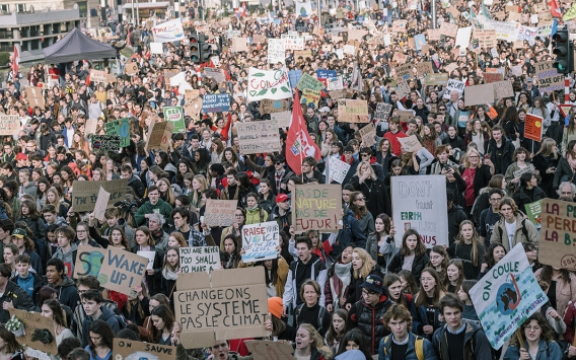De CO2 uitstoot vorig jaar een record heeft bereikt? [1]
De temperatuur zal stijgen met 3,5°C, zelfs als alle landen hun gedane beloftes houden i.v.m. de CO2 uitstoot en groene technologie? [2]
Daardoor de zeespiegel met twee meter zou kunnen stijgen waardoor honderden miljoenen mensen zouden moeten verhuizen? [3]
Dat het bijna zeker is dat we zullen af te rekenen hebben met een toename van extreem warme en koude temperaturen alsook met meer droogtes en overvloedige regenval? [4]
Dat desondanks de VS-burgers – de grootste uitstoters van de wereld – steeds minder geloven dat de aarde opwarmt, ze er nauwelijks wakker van liggen en slechts een derde ervan gelooft dat de klimaatopwarming het gevolg is van menselijke activiteiten? Een recente opiniepeiling legde een lijstje voor van 22 topprioriteiten. Daar eindigde de klimaatopwarming op de voorlaatste plaats, nog net voor obesitas, met een score van 26%. Bovenaan stonden economie (87%), jobs (84%) en terrorisme (73%). [5]
Dat volgens het World Wild Fund Cuba het enige land is met een hoge sociale ontwikkeling en een lage voetafdruk? [6]
Er jaarlijks 1.500 miljard dollar zou moeten geïnvesteerd worden om de temperatuurstijging tot 2°C te behouden en dat er nu er jaarlijks amper zo’n 100 miljard dollar wordt geïnvesteerd? [7]
Dat als gevolg van de eurocrisis de huidige investeringen dreigen gehalveerd te worden? [8]
Dat China ondertussen de grootste investeerder geworden is op het vlak van hernieuwbare energie en ze in de periode 2009-13 driemaal zoveel investeren als de VS? De investering waren in China in 2010 goed voor 130GW. Daarna volgden de VS met 58GW en Duitsland met 49GW. [9]
Dat 7% rijksten van deze planeet 50% CO2 uitstoten terwijl de 50% armsten 7% CO2 uitstoten? [10]
China het meest CO2 uitstoot, maar dat dit land per inwoner driemaal minder uitstoot dan de VS en een derde minder dan Europa? [11]
Het de cumulatieve uitstoot is die verantwoordelijk is voor de opwarming en dat de rijke landen daarin voor 76% verantwoordelijk zijn en China voor 8%? [12]
In deze rubriek brengt veellezer Marc Vandepitte markante feiten, cijfers of quotes van over heel de wereld die in de andere media weinig of geen aandacht kregen, maar zeker het vermelden waard zijn om de chaotische wereld van vandaag te begrijpen.
Bronnen
[1] ‘On planned policies, rising fossil energy use will lead to irreversible and potentially catastrophic climate change. Global energy-related emissions of carbon dioxide (CO2) – the principal greenhouse gas – jumped by 5.3% in 2010 to a record 30.4 gigatonnes (Gt).’ International Energy Agency, ‘World Energy Outlook 2011 Factsheet’, https://selectra.co.uk/sites/selectra.co.uk/files/pdf/co2highlights.pdf, p. 2.
[2] ‘In the New Policies Scenario, our central scenario, emissions continue to rise, reaching 36.4 Gt in 2035 – an increase of 20%. This trajectory is consistent with a long-term global temperature increase of more than 3.5°C.’ Ibid, p. 2.
[3] ‘An increase of this size would have severe consequences, including a sea level rise of up to two meters—causing dislocation of human settlements—and drought, floods and heat waves that would severely affect food production, rates of disease and mortality, the IEA said.’ The Wall Street Journal, 10 november 2011, http://online.wsj.com/; Financial Times, Climate Change Insight – Durban 2011, 25 november 2011, p. 4.
[4] ‘It is virtually certain that increases in the frequency and magnitude of warm daily temperature extremes and decreases in cold extremes will occur in the 21st century on the global scale. It is very likely that the length, frequency and/or intensity of warm spells, or heat waves, will increase over most land areas.’
‘It is likely that the frequency of heavy precipitation or the proportion of total rainfall from heavy falls will increase in the 21st century over many areas of the globe.’
‘There is medium confidence that droughts will intensify in the 21st century in some seasons and areas, due to reduced precipitation and/or increased evapotranspiration.’
IPCC, Managing the Risks of Extreme Events and Disasters to Advance Climate Change Adaptation, Cambridge, 18 november 2011, http://www.ipcc.ch/news_and_events/docs/ipcc34/SREX_FD_SPM_final.pdf, p. 10 en 11.
[5] ‘The overall share of Americans who say the earth is warming has declined over the past five years. In 2006, 77% said there is solid evidence of global warming. That fell sharply from 71% in 2008 to 57% in 2009 and now stands at 58%.’ Pew Research Center, 3 november 2011,
http://www.people-press.org/2011/11/03/section-8-domestic-and-foreign-policy-views/.
‘Roughly a third (34%) say that global warming is occurring mostly because of human activity, such as the burning of fossil fuels, which also is little changed from last year (36%).’
Pew Research Center, 27 oktober 2010, http://www.people-press.org/2010/10/27/little-change-in-opinions-about-global-warming/.
Opiniepeiling over prioriteiten: Pew Research Center, 20 januari 2011, http://www.people-press.org/2011/01/20/economy-dominates-publics-agenda-dims-hopes-for-the-future/.
[6] ‘In 2003, Asia-Pacific and Africa were using less than world average per person biocapacity, while the EU and North America had crossed the threshold for high human development. No region, nor the world as a whole, met both criteria for sustainable development. Cuba alone did, based on the data it reports to the United Nations.’, World Wild Fund, Living Planet Report 2006, Gland 2006, p. 19.
Voor de ecologische kwestie in Cuba, zie Vanbrabant I. & Demuynck K., Cuba. Revolutie met een groen hart, Brussel, 2010, http://cubanismo.net/cms/nl/shop/cuba-revolutie-met-een-groen-hart.
De Human Development Index van Cuba is 0,904, die van de rijke landen 0,918 en het gemiddelde van de wereld 0,683. De ecologische voetafdruk (uitgedrukt in ha per persoon) van Cuba is 1,9, die van de rijke landen 5,9 en het gemiddelde van de wereld 2,4. UNDP, Human Development Report 2011, New York 2011, p. 127, 130, 146 en 149.
[7] ‘Large-scale investment in future energy supply is needed. In the New Policies Scenario, $38 trillion in global investment in energy-supply infrastructure is required from 2011 to 2035, an average of $1.5 trillion per year. Two-thirds of this is required in non-OECD countries.’ International Energy Agency, ‘World Energy Outlook 2011 Factsheet’, http://www.iea.org/weo/docs/weo2011/factsheets.pdf, p. 1; Financial Times, Climate Change Insight – Durban 2011, 25 november 2011, p. 6.
[8] Een recent rapport spreekt van een vermindering van minstens 23 miljard dollar de volgende jaren, maar dat zou kunnen toenemen tot 45 miljard dollar als gevolg van de besparingsmaatregelen in de Europese Unie. Ernst & Young, ‘Durban dynamics: navigating for progress on climate change’, http://www.ey.com/Publication/, p. 3. Cfr. Reuters, ‘Euro zone crisis to widen climate fund gap – report’, 17 november 2011, http://www.reuters.com/article/2011/11/17/climate-finance-idUSL5E7MH13720111117.
[9] Cijfers voor 2010: The Pew Charitable Trust, 29 maart 2011, http://www.pewtrusts.org/news_room_detail.aspx?id=329368. De investeringen voor de periode 2009-13 in China: 400 miljard dollar, voor de VS 140 miljard dollar. The Economist, 7 augustus 2010, p. 55.
[10] Pearce F., 13 april 2009, ‘Consumption Dwarfs Population as Main Environmental Threat’, http://e360.yale.edu/feature/consumption_dwarfs_population_as_main_environmental_threat/2140/.
[11] International Energy Agency, CO2 Emissions from Fuel Combustion Highlights. 2011 Edition, Parijs 2011, http://www.iea.org/co2highlights/co2highlights.pdf, p. 12.
[12] WWF, Emerging Leaders. How the developing world is starting a new era of climate change leadership, November 2009, http://www.worldwildlife.org/climate/Publications/WWFBinaryitem15236.pdf, p. 9; http://pdf.wri.org/navigating_numbers_chapter6.pdf p. 32.






















